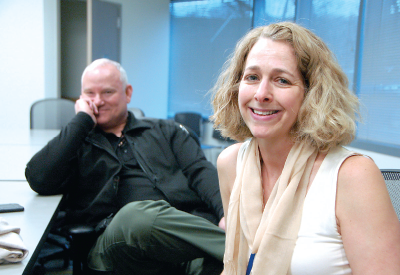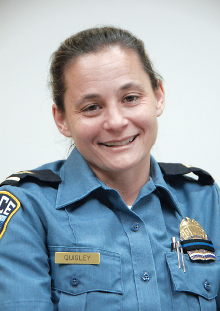The monthly meeting of the Arlington County (Va.) Mental Health Criminal Justice Review Committee illustrates just what it may take to reduce the number of people with mental illness in America’s jails—patience, cooperation, time, persistence, commitment, and a lot of time showing up at monthly meetings.
What happens in Arlington is a snapshot of how counties around the country are learning to cope with the problem.
Every agency—and it’s quite a list—concerned with the intersection of mental health and criminal justice in Arlington County regularly attends this meeting. For a start, members of the county’s behavioral health care staff are there—the forensic team, the crisis intervention team coordinator, a therapist and social worker from the county jail, substance use staff, an emergency services therapist, a family representative, peer specialists, and senior management. Representatives from the sheriff’s and police departments are there, too. So are those from the magistrate’s office, the public defender, prosecutor, community corrections, and the district court judge’s office. A psychology professor from a local university who helps train police officers sits in, too.
At the April meeting, the 20 or so attendees went down a list of recent accomplishments and wrestled with new problems:
A new mental health therapist started late last year, and recruitment had begun for another position for a bilingual candidate. The police department increased its weekly hours to provide security at the Crisis Intervention Center. Discussion of the creation of a mental health court or docket continued. The jail social worker said she wants to talk again with the jail’s mental health contractor over the scheduling of psychotropic medication prescriptions for inmates.
The points raised may seem routine, but they reflect the philosophy upon which the county’s program rests: Keep talking, keep listening, develop consensus among people and agencies with different priorities, and make incremental, but steady, progress over time.
In fact, Arlington County appears to be one of many jurisdictions developing systems to divert nonviolent, mentally ill arrestees as much as possible from simply cycling through the criminal justice system. Filling jails with such people does little good for public safety, for the person with mental illness, or for taxpayers.
Cooperation in Arlington County goes back 25 years, said Leslie Weisman, L.C.S.W., chief of the Client Services Entry Bureau and director of Arlington’s Crisis Intervention Center. Emergency therapists began building bridges by attending recruit training, riding on patrol with officers, and sitting in on roll calls. Eventually, a police captain was assigned as an intermediary between the two agencies.
More was needed, though, and so the seeds of the review committee were planted in 2003 with an assessment of the needs and gaps in the county’s handling of people with serious mental illness involved in the justice system.
Weisman worked closely with police Capt. Brian Berke, M.S., a 30-year veteran of the force, for five years to develop a proposal for a round-the-clock crisis intervention center and start crisis intervention team (CIT) training for officers. Later, the committee began addressing issues like the re-entry of prisoners to the community, postbooking diversion, trial competency, the role of forensic peer specialists, and safer transfer-of-custody procedures. The next step, a mental health court, awaits authorization by the state legislature.
The county’s procedures are based on the sequential intercept model developed by psychiatrist Mark Munetz, M.D., Henry Steadman, Ph.D., of PRA Associates, and Patricia Griffin, Ph.D., of the National GAINS Center for People with Co-occurring Disorders in the Justice System.
“I believe the model has been helpful to communities and has been widely adopted as an approach to the problem,” Munetz told Psychiatric News. “A number of states and many counties across the country have used it as a framework.”
The model creates numerous points of intervention—“intercepts”—to “prevent individuals from entering or penetrating deeper into the criminal justice system,” and to get them into treatment as soon as possible. The system provides alternatives beginning with the 911 dispatcher and continues through law enforcement contact, booking, courtroom, entry and discharge from jail, probation and parole, and community support and treatment.
When called to the scene of a disturbance or petty crime committed by a person with a probable mental illness, an officer can begin by asking the individual to voluntarily go for evaluation or treatment. If desperate family members call 911 for help, they can request a CIT-trained officer. The officer can consult by phone with an emergency services therapist who has access to prior reports of the person’s mental health status.
If there are no apparent acute medical issues, the officer transports the individual to the County’s Crisis Intervention Center (CIC), which is staffed by clinicians 24 hours a day, seven days a week. The CIC provides immediate assessment, office-based crisis stabilization, and referral to higher levels of care, including hospitalization, as required. The CIC also has several “calming rooms” where persons in crisis can remain for up to 23 hours, referred to as Office-Based Crisis Stabilization.
When required in more severe cases, a temporary detention order allows the officer to transport the individual for medical clearance. That is not unusual since many of those detained also have comorbid physical ailments. If needed, beds are found at the nearby Virginia Hospital Center. State law requires locating a bed within eight hours, and Virginia state hospitals serve as the reserve for that mandate. That option can tie up two officers for an entire shift to transport the patient.
“We have to make sure they land in a bed, not back on the street,” said Weisman.
The system sees about 2,200 cases a year of whom between 280 and 350 are held on temporary psychiatric detention orders, generally at area hospitals. Data are collected on a number of parameters, such as the time it takes the police to transfer custody; recidivism; and the numbers of persons who go to community care, crisis stabilization, voluntary treatment, or involuntary detention.
The system may work well today but it took time to convince the police chief in the early years of the value of alternatives to arrest and to persuade supervisors to give officers 40 hours off from patrol duties for CIT training.
“Jail diversion is hard for officers to accept,” said Berke. “They think their job is to arrest people.”
If the old view was “lock ’em up,” younger officers see CIT training and a more nuanced approach to mental illness as the norm today, said police Capt. Adrienne Quigley, M.P.A., the current liaison officer. “That also reflects a shift in the culture to de-escalation across the board to minimize the use of force as much as possible.”
Lessening the resort to force also lessens the risk of injury to both individuals with mental illness and officers, which may account for at least some of the change in thinking about CIT.
There are limits, however. An assault on an officer is dealt with as a crime, no matter what, said Quigley. “Nothing can compromise officer safety. Just because someone has a mental illness does not give the individual carte blanche to commit crimes, so officers still have a lot of discretion.”
“I’m impressed with the relationship between the clinical staff and the officers in the field,” said psychiatrist John Palmieri, M.D., medical director for the county’s Community Services Board. “It’s a relationship built over time with mutual respect and trust to collaborate on improving the care that individuals get.”
And taken together, Berke emphasized, CIT, the sequential intercept model, and the CIC are tools, not panaceas.
“In the past, we had only a hammer,” said Berke. That was arrest. “Now we have lots of tools, and if people are taught to use them, they will use them and build better.” ■



